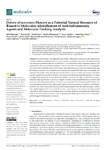Datura stramonium Flowers as a Potential Natural Resource of Bioactive Molecules: Identification of Anti-Inflammatory Agents and Molecular Docking Analysis

Use this link to cite
http://hdl.handle.net/2183/37413Collections
- Investigación (FCIE) [1228]
Metadata
Show full item recordTitle
Datura stramonium Flowers as a Potential Natural Resource of Bioactive Molecules: Identification of Anti-Inflammatory Agents and Molecular Docking AnalysisDate
2023-07-04Citation
Damergi, B.; Essid, R.; Fares, N.; Khadraoui, N.; Ageitos, L.; Ben Alaya, A.; Gharbi, D.; Abid, I.; Rashed Alothman, M.; Limam, F.; et al. Datura Stramonium Flowers as a Potential Natural Resource of Bioactive Molecules: Identification of Anti-Inflammatory Agents and Molecular Docking Analysis. Molecules 2023, 28, 5195, doi:10.3390/molecules28135195.
Abstract
[Abstract] The present study investigated the antioxidant, antibacterial, antiviral and anti-inflammatory activities of different aerial parts (flowers, leaves and seeds) of Datura stramonium. The plant material was extracted with 80% methanol for about 24 h. The sensitivity to microorganisms analysis was performed by the microdilution technique. Antioxidant tests were performed by scavenging the DPPH and ABTS radicals, and by FRAP assay. Anti-inflammatory activity was evaluated through the inhibition of nitric oxide production in activated macrophage RAW 264.7 cells. Cell viability was assessed with an MTT assay. Results show that the flower extract revealed a powerful antimicrobial capacity against Gram-positive bacteria and strong antioxidant and anti-inflammatory activities. No significant cytotoxicity to activated macrophages was recorded. High resolution electrospray ionization mass spectrometry and nuclear magnetic resonance analysis identified two molecules with important anti-inflammatory effects: 12α-hydroxydaturametelin B and daturametelin B. Molecular docking analysis with both pro-inflammatory agents tumor necrosis factor alpha and interleukin-6 revealed that both compounds showed good binding features with the selected target proteins. Our results suggest that D. stramonium flower is a promising source of compounds with potential antioxidant, antibacterial, and anti-inflammatory activities. Isolated withanolide steroidal lactones from D. stramonium flower extract with promising anti-inflammatory activity have therapeutic potential against inflammatory disorders.
Keywords
Anti-inflammatory
Bioactive molecules
Datura stramonium
Molecular docking
HR-ESI-MS
NMR
Bioactive molecules
Datura stramonium
Molecular docking
HR-ESI-MS
NMR
Editor version
Rights
Atribución 3.0 España
ISSN
1420-3049






